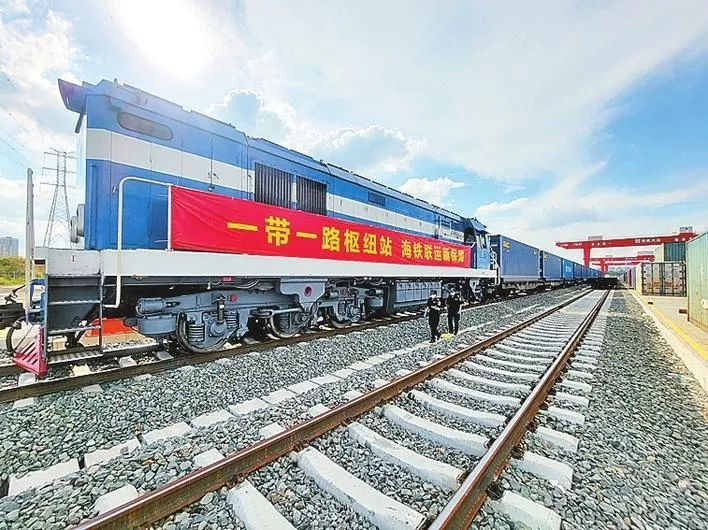More than a decade ago, behind the birth of the China Europe freight train, there were many considerations from top-level designers. For example, breaking down the natural barriers in the western inland areas that are far from the sea, allowing China's relatively underdeveloped central and western regions to have their own import and export portals, in line with the trend of multinational enterprises reducing production costs, transferring and improving their own supply chains, attracting new industrial clusters, and promoting regional economic development.

Of course, there is also a broader consideration - the consideration of supply chain stability and national interest security. People often say that a Strait of Malacca can directly feel China's serious dependence on maritime transportation routes -1/4 of global cargo trade, 1/3 of oil transportation is transported through the Strait of Malacca, and 90% of China's trade goods rely on sea transportation.
Therefore, we are attempting to establish the China Pakistan Economic Corridor, hoping for a land route to help us bypass the "predicament" of Malacca.
In the same context, a railway transportation network that starts from central and western China in the east, connects to the industrial hinterland of Europe in the west, and connects the Eurasian continent can become a powerful option in the contingency plan.
Unexpectedly, the sand table exercise of the past quickly became a reality. Malacca is still smooth, but the international supply chain has faced repeated challenges.
The COVID-19 epidemic has raged for three years, making the marine supply chain extremely fragile. Significantly reduced ship voyages, isolated dock workers, habitable cargo spaces, and skyrocketing shipping costs
The Suez Canal, which is as important as the Strait of Malacca, also encountered the embarrassing situation of a "long ship" running aground. The seemingly brief 6-day congestion, with over 300 ships suspended, delayed cargo supply, and congestion at the back-end port... The subsequent impact lasted for several months.
Today, the maritime supply chain is experiencing a new ordeal.
Chinese factories provide raw materials, components, and consumer goods, while freight forwarders and logistics suppliers cross half the globe to transport goods to warehouses and markets in the West. The sensitivity of participants in this chain to geopolitical risks has far exceeded that of many other industries.
The supply chain is a ship that operates strictly according to plan. Once it deviates from the route, freight costs and industry sentiment will experience significant fluctuations.
The attacks on merchant ships caused by geopolitical conflicts and wars have led to chaos in the Red Sea and Suez Canal waterways. About 12% of global trade passes through the Suez Canal.
Maersk announced on the 5th that all ships will no longer pass through the Red Sea in the foreseeable future and warned customers to prepare for serious supply disruptions. Other major shipping companies such as Delta Shipping, Mediterranean Shipping, and Herbert have all avoided the Red Sea.
Sailing around the Cape of Good Hope in Africa requires an additional 10 days to two weeks of travel, and higher fuel costs also push up shipping costs. According to the International Monetary Fund's PortWatch, the traffic volume on the Cape of Good Hope route has increased by nearly 70% so far this year.
Drewry, a shipping consultancy, believes that this interruption occurred during a particularly sensitive period when Chinese producers were eager to ship goods to Europe before the Lunar New Year. The freight rate for a 40 foot container from China to Northern Europe has increased from $1148 at the end of November last year to about $4000 today.
The end of conflicts and wars is far away, with delivery delays, rising freight rates, and subsequent port congestion and shortage of empty containers... Concerns about the stability of air routes may become a long-term concern for people.
In this situation, many people have turned their hopes to China Europe railway and road transportation, and the number of inquiries and bookings for China Europe freight trains has surged.
However, the losses caused by the Red Sea crisis to the international trade supply chain cannot be compensated for by the China Europe freight trains or international road transportation.
From the perspective of source structure, higher value goods suitable for railways and highways are different from traditional sea freight. A large number of low value-added, primary commodities are actually unable to cover the costs of China Europe freight trains and international truck transportation.
In terms of overall transportation volume, the sea freight volume is not comparable to the current China Europe freight trains and trucks.
There is still too much international cooperation and political effort needed regarding the topic of supply chain security.
If we return to the China Europe freight train, transportation costs, timeliness, and safety constitute several decisive factors in transportation. Customers always seek the best balance between these elements. The China Europe freight train experienced market indifference in a geopolitical conflict between Russia and Ukraine, and regained the attention of customers in the geopolitical conflict of Husai's attack on the Red Sea. The original intention is to focus on long-term expansion channels, expand transportation capacity in the medium term, and grasp the current service quality.
China Trade Express Logistics, being a reliable freight forwarder, synchronizing with world life!

China Trade Express Logistics (ShenZhen) Co., Ltd 粤ICP备20062912号